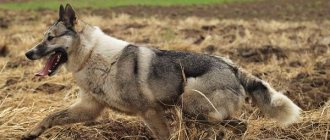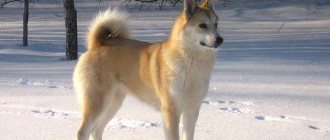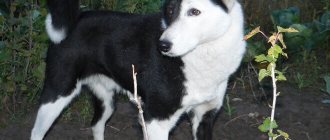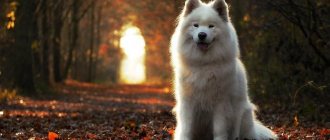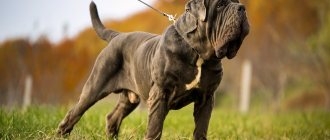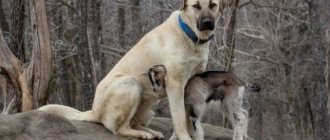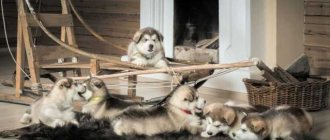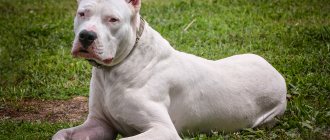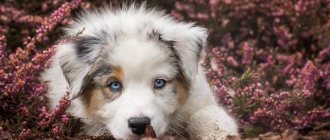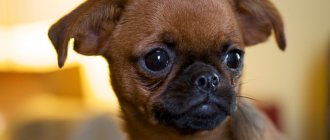Basic moments
- Karelian-Finnish huskies were bred as universal hunters, equally adept at handling both squirrels and roe deer.
- The excess of cunning and independence among representatives of this breed somewhat hinders them in their studies. Sometimes an animal can be stubborn and pretend, so you will have to look for a special approach to these red-haired rogues.
- Like most hunting dogs, Karelian-Finnish huskies are very energetic animals that require regular physical exercise, so you will have to walk your pet a lot and thoroughly.
- The average “Karelo-Finn” quickly settles into the family, but can conflict with other representatives of the dog tribe if he sees them as rivals. The desire to lead and dominate - nothing can be done.
- The Karelian-Finnish husky is a noisy dog, loving to raise its voice even on the most insignificant occasion, so before you get a tiny red lump, ask yourself: are you ready to live in the company of such a talkative pet.
- Fearlessness and courage are the main hunting characteristics of Karelian-Finnish huskies. At the same time, they are quite prudent and do not attack too large animals.
- One of the most significant advantages of the breed is the compactness of its representatives, in comparison with other huskies. Such dogs do not require much space and are easy to transport, which is important for owners who regularly go hunting with their pets.
- Among lovers of the Karelian-Finnish Laika breed, they are simply called Karelians.
Health
The average life expectancy of the Karelian Laika is about 13-15 years. The main condition for maintaining health is daily physical activity, which is necessary for representatives of hunting breeds.
In addition, it is important to properly care for your pet and provide a balanced diet. Do not forget to undergo preventive examinations with your husky at the veterinary clinic once a year, carry out routine vaccinations, and treatment for skin parasites. Deworming is also required.
The Karelian woman is in good health and has a strong immune system. The breed is little susceptible to hereditary diseases. Problems rarely arise during reproduction; females give birth easily, with rare exceptions.
The list of health problems to which the Karelian-Finnish Laika is predisposed is very small:
- Eye pathologies are developmental abnormalities.
- Epilepsy - accompanied by seizures, convulsions, and involuntary bowel movements.
- Limb dislocations.
- Allergies – food allergies are more common.
- Joint dysplasia – characterized by severe pain and lameness.
History of the Karelian-Finnish Laika breed
The Karelian-Finnish Laika is perhaps the most deprived of the domestic breeds, whose representatives were never awarded their own standard and were absorbed into the more popular canine clan.
Karelian Laikas appeared in Tsarist Russia at the end of the 19th century, and their main concentration was in the north and west of the country. Subsequently, animals living in the border areas began to spontaneously interbreed with Finnish hunting dogs, which led to the birth of a separate breed branch. In fact, these were the first Karelian-Finnish huskies, with which residents of the northern provinces very successfully hunted wood grouse. In 1936, Karelians went to the All-Union Agricultural Exhibition, where they pleasantly surprised dog handlers. And in 1939 they even tried to standardize them, but first the low number of livestock, and then the Great Patriotic War, prevented the matter. In the late 40s, Soviet breeders set out to turn Karelian-Finnish Laikas into universal hunters by starting to breed them with Finnish Spitz. As a result, the animals dramatically improved their exterior performance, which became the impetus for the large-scale import of Finnish Spitz into the USSR and the subsequent uncontrolled pumping of the breed. It got to the point that by the 80s, most individuals from domestic nurseries carried 70% Finnish Spitz blood.
In 1984, the question of standardizing Karelian-Finnish Laikas arose again. This time, members of the Leningrad Society of Hunters and Fishers decided to solve the problem, but they did not bother too much and classified the animals as members of the Finnish Spitz family. However, the final “disbandment” of the breed occurred only in 2006, after the chairman of the Finnish Kennel Club and the president of the RKF signed an official agreement, according to which the Finnish Spitz and the Karelian-Finnish Laika were declared a single breeding branch and received a common standard of appearance. This created the illusion of some order, but did not stop the debate about the differences between both canine clans. In particular, modern experts involved in testing the hunting talents of “Finns” and “Karelians” assure that the working performance of dogs is not the same, and the merging of two breeds into one did not bring any practical benefit to either the animals or their owners.
Peculiarities
Finnish Laikas are excellent hunters and wonderful companions that can be kept even in urban environments. They treat the family warmly. Attached to their owners. Loyal and faithful. Guests are treated with polite composure. They do not show open hostility. In case of danger, they are able to protect their charges.
This is a very sensitive dog that will support you in difficult times in any way. He loves long walks. On long journeys it will serve its owner faithfully. It is oriented to the area, so with such a friend you definitely won’t get lost.
Laika is a very smart dog that quickly learns new information. She has a fairly independent character, so some effort is required during the training process. Violent methods must not be used during the learning process. Laika appreciates friendly and gentle treatment. It can quickly lose trust in the owner, which will then be very difficult to restore.
This is a very talented and versatile dog that can show itself from different sides. This is an excellent hunter, watchman, assistant and friend.
Appearance of the Karelian-Finnish Laika
The Karelo-Finnish Laika is a medium-sized hunting breed, with fluffy “honey” fur and brown or black eyes. The dog has a dry, strong type of constitution, almost square in format. “Boys” are on average slightly larger and more massive than “girls.” The breed standard defines the following parameters: height at the withers – 42-50 cm (for males) and 38-46 cm (for females); body weight – 12-13 kg and 7-10 kg, respectively.
Head
The Karelian skull looks oval on top and slightly convex on the sides. The brow and occipital protuberance are not very pronounced, as is the frontal groove. The feet of representatives of this breed are clearly drawn, but not too sharply. The muzzle is narrow, with a flat back, and dry.
Jaws and teeth
The dog's jaws are massive, closed in a tight scissor bite. The teeth are strong, even, symmetrically set.
Nose
The lobe is miniature, charcoal in color.
Eyes
Karelian-Finnish huskies have not very large, almond-shaped eyes, set somewhat obliquely. The iris of the eye is dark colored.
Ears
Ears are set high and erect. The ear flap is small, pointed in shape, the outer side is hidden under a layer of thick short hair.
Neck
The neck of the Karelian-Finnish Laika is of normal length, but due to the voluminous woolen “collar” it gives the impression of being short and thick.
Frame
The correct “Karelo-Finn” has a strong physique. The body of the dog is square in shape with a straight back, a massive, sloping croup and well-defined withers. The stomach is slightly tucked.
Limbs
The legs of the Karelian-Finnish Laika are straight, set parallel to each other. The front legs are characterized by well-developed bones, mobile, slightly inclined shoulder blades and normal length pasterns. The hind legs of this breed are strong, with fleshy thighs, muscular shins and low set hocks. The dog's paws are round, almost cat-like, with the front ones slightly shorter than the back ones.
Tail
The length of the tail of the Karelian-Finnish husky is up to the hock joint. The section of the tail bordering the base is turned sharply towards the back, which is why the rest of it rushes down and hangs down to the hip.
Wool
On the head and the front of all four limbs the hair is relatively short. On the body, tail and hips the coat is longer, more luxuriant, noticeably lagging behind the body. The guard hair on the shoulder blades of male dogs is especially noticeable - it is hard and stands almost straight up.
Color
The backs of Karelian-Finnish huskies are more intensely colored and come in rich red or reddish-golden tones. The dog's cheekbones, insides of the ears, legs and tail, as well as the chest and underbelly are noticeably lighter. The presence of white spots on the paws and a light mark on the chest is considered normal.
Disadvantages and defects of the breed
The most typical defects of Karelian-Finnish huskies are a large head, a heavy muzzle, an underdeveloped lower jaw, and an excessively or insufficiently curled tail. Often among Karelians one can find such deviations from the standard as sharp transitions between shades of color, ears hanging to the sides, ears tilted back or tips directed towards each other, as well as soft pasterns. If we talk about disqualifying defects of the breed, then these include:
- blue and yellow colors of the iris;
- the tips of the ears are too soft;
- any deviations from the standard bite;
- wool with a wave or pronounced curl;
- large white markings on the chest and the same “socks” on the animal’s legs;
- depigmented lobe;
- unjustified aggression directed at a person.
Mating
Only functionally and clinically healthy pets that do not have obvious deviations from the breed standard are allowed for breeding. The optimal time for mating is after the onset of the third heat. Finnish Spitz males are ready for breeding at the age of 18-20 months.
Dogs are wormed and vaccinated in advance. First, the pets are introduced on neutral territory, then the bitch is brought to the male. Animals are usually mated freely, but some males may snap or bite. In this case, an experienced instructor should intervene.
Karelian pregnancy lasts 62-65 days. However, the period may decrease or increase slightly - it all depends on the size of the litter. In most cases, huskies give birth on their own. But the owner must control the process in order to help the animal if necessary. Most often, 3-4 puppies are born in one litter.
Character of the Karelian-Finnish Laika
The Karelian-Finnish Laika is a cheerful, positive creature, but at the same time with a great sense of self-esteem, which even a beloved and adored owner should not offend. In general, “Karelo-Finns” are self-sufficient pets, responding with an even, friendly attitude to good treatment and distrust and nervousness to a rude, authoritarian leadership style. By the way, the easiest way to understand that a four-legged friend is offended is by the tail, which straightens in irritated animals.
In childhood and adolescence, the Karelian-Finnish husky gives the impression of being extremely dependent on its owner. She is obedient, efficient, and catches every glance of her mentor. But the older the dog gets, the faster its sense of self-worth grows. So stubbornness and independence are traits that you will almost certainly encounter in a four-year-old Karelian and almost never in puppies. However, if it seemed to you that the Karelian-Finnish huskies are fixated only on themselves, then you really did. The Finnish Spitz of the Karelian spill is a good telepath and perfectly senses the mood of its owner. He is far from slow-witted, so he quickly figures out what actions are expected of him, and builds his own line of behavior in accordance with this.
Karelian-Finnish Laikas openly dislike strangers suddenly invading private territory, so raising a representative of this breed to be a house watchman is as easy as shelling pears. As for the children, the dogs have a friendly relationship with them, although not always ideal. That is, the Karelian, of course, is not averse to playing catch-up with the kids, but in response to violence or outright infringement of his own rights, he can make a warning “Woof!” In general, Karelian-Finnish huskies are very convenient companions not only for professional hunters, but also for adherents of an active lifestyle. They will never refuse to run with their owner through city parks and will happily go to any picnic if you just whistle.
Socialization
Finnish Spitz are quite difficult to socialize. This feature of the breed is associated with the innate independence of animals. Karelian husky puppies require appropriate upbringing from childhood.
If a dog was bred for hunting, it is taken to the forest at 3-4 months. An adult pet will be frightened by unfamiliar sounds - he will behave timidly and insecurely.
Favorite companions are accustomed to life in the city - they are walked on noisy streets, introduced to new people and other dogs. Initial training helps to establish contact with the pet, which facilitates its further education.
Finnish Spitz are not very fond of other dogs. At best, the animal will not pay attention to the animal, at worst, it will start a fight. But if pets grow up in the same territory since childhood, they become excellent friends. The same situation is observed in relation to other pets, including cats.
Cheerful and cheerful Finnish Spitz get along with children, but the latter should not cross the boundaries of what is permitted. An independent pet should not be pulled by the ears and tail, or squeezed if it does not want to. The child should be told in advance about the rules of behavior with the animal.
Hunting with Karelian Laika
Despite the versatility of the breed in terms of hunting, it is more advisable to go with Karelian-Finnish huskies to hunt small fur-bearing animals (squirrels, marten) and wood grouse. Karelians are excellent at finding and stopping game, masterfully scaring the animal away when shot, and finally taking away the shot prey. Theoretically, you can bait a puppy as early as four months, but not all huskies at this age have sufficient intelligence. So if at the first lesson the dog does not show interest in the animal, you should wait another month or two. By the way, training a Finnish Spitz to hunt a bear, which has become unexpectedly popular lately, is more of a show than a real hunt. It’s one thing to bark at a decoy clubfoot at the baiting station, and quite another thing to provoke a wild brat near his native den. Of course, in the biographies of individual Karelians, this type of hunting also takes place, but this is already aerobatics, which only a select few succeed in, and only after numerous and tedious training.
Sometimes the hunter's instinct can lie dormant in a Finnish Spitz for up to one and a half years. There is no need to be afraid of this, since Karelian-Finnish huskies are excellent at catching up. The main thing is to keep your pet interested in work. For example, you can periodically give animal skins or killed birds for your puppy’s personal use. If you have a second dog that has already taken part in the hunt, take that one as well. Looking at the behavior of the older comrade, the puppy will definitely try to copy him.
When working with large animals, representatives of this breed are especially careful, they do not lose their minds and never forget about the rules of their own safety. The Karelian-Finnish husky keeps a respectful distance from the angry boar, while never ceasing to bark at it. By the way, such a cautious approach does not affect prey in any way: red-haired Karelians almost never leave the forest without a trophy.
Suitable nicknames
Choosing a nickname for a husky is the most important task, because the name will accompany the animal throughout its life.
Important! You should not call animals by human names or the names of former pets who have already died.
For Laika girls, nicknames such as:
- Alma;
- Eve;
- Naida;
- Taiga;
- Lada;
- Ida;
- Vesta;
- Laura;
- Lasta;
- Nera;
- Aurora.
An adult husky next to its owner
A Laika boy can be called:
- North;
- West;
- Fog;
- Thunder;
- Gift;
- Arcos;
- Fox;
- Fox;
- Red;
- Oscar;
- Jerry;
- Balto.
A potential owner of a fiery husky should sensibly assess his strengths and resources. Owning a representative of this breed means taking responsibility for its life. You should prepare in advance to give your dog love and then it will reciprocate.
Maintenance and care
The Karelian-Finnish husky is not an aviary and certainly not a chain dog. Her place is in the house, in the company of a kind, understanding owner and members of his family. In addition, despite the fact that this variety of husky has a reputation among hunters as “cold-resistant,” Russian frosts are not for it. As a compromise, the pet can be periodically moved to a kennel in the yard, but only in the warm season. And by the way, don’t really count on the fact that the furry hunter will be very happy about such a move.
It is imperative to equip a puppy with a separate sleeping place in the house, as well as accustom him to it. Otherwise, in your absence, the Finnish Spitz will rest on your own bed. So in the first weeks of the dog’s residence in your home, do not be lazy to cover the expensive sofa with newspapers - huskies usually do not encroach on a rustling bed.
From the age of one and a half months, Karelian-Finnish huskies begin to be walked. The first walks can last 15-20 minutes, but as the dog gets older they should be increased. It is optimal if the animal is taken outside twice a day for 2-3 hours. This is especially important for Karelian women living in a large city, who need to compensate by walking for the lack of opportunity to hunt. By the way, due to developed stalking instincts, huskies are taken out of the house on a leash, otherwise there is a risk of losing the perky saffron milk cap forever.
Hygiene
There is no need to stand guard near the Karelian-Finnish husky with a furminator and lotion to facilitate combing, since the fur of representatives of this breed is problem-free, almost does not smell like a dog and sheds twice a year. Brush the Karelian with a metal comb a couple of times a week and daily during the shedding period. You can bathe an adult dog no more than 2-3 times a year. Remember that the husky, which regularly goes hunting, already takes unscheduled baths, jumping into the swamps for shot game.
The eyes of the Karelian-Finnish Laika are relatively healthy, not prone to the formation of nitrous oxide, so they do not require special care. The only thing - do not forget in the morning to remove lumps from the corners of the eyes, the formation of which is provoked by dust that gets on the mucous membrane. To do this, soak a clean cloth in chamomile infusion and gently wipe your eyes. If you notice purulent discharge, redness or increased tearfulness in your pet, visit a specialist - herbal decoctions alone cannot eliminate such problems.
Once a week it is necessary to allocate time for a thorough examination of the dog’s ears, and once a month the Karelian-Finnish husky should have its nails trimmed. Brushing your teeth is also mandatory for Karelians, so every 3-4 days, arm yourself with a paste and a cleaning attachment and treat the oral cavity of your ward. It’s best to remove plaque in a veterinarian’s office, but preventive measures can be taken to combat it at home. In particular, systematically treat your Finnish Spitz with pressed treats from the pet store and fresh tomatoes.
Like all hunting dogs that regularly go into the forest, the Karelian-Finnish husky requires increased protection against ticks, so do not skimp on products against ectoparasites. In addition, from May to September (peak tick activity), inspect your pet's fur after a walk. If you notice that a “free passenger” has clung to the karelka, pull it out with a twisting motion of tweezers and wipe the bite area with chlorhexidine. Now all that remains is to observe the behavior of the animal. If the Karelian-Finnish husky is playful and eats normally, you can breathe a sigh of relief - you have found a safe parasite. If the dog refuses food, looks apathetic, has a fever, and its urine has acquired a brownish tint, take it to the vet immediately.
Feeding
Compared to other, larger huskies, Finnish Spitz look like real little dogs. At the same time, the energy from these red creatures flows like a fountain. Breeders usually already feed three-week-old puppies, so by the age of 2-3 months, Karelian babies completely switch to the adult diet. Approximately 20% of a teenage dog's diet is lean meat. It is better if it is not a frozen product, but a steamed one. The first option is also possible, but only after thorough thawing.
Karelian-Finnish Laika puppies are always given meat cut into pieces and never in the form of minced meat, which flies through the digestive tract at an accelerated pace and does not bring satiety. Bone cartilage is also a healthy product and a source of natural collagen, so huskies can eat them as early as 7 weeks of age. But it’s better to wait with bones until the puppy is at least 3 months old.
It is better to start introducing the animal to cereal products with milk semolina porridge, after a month or two replacing it with oatmeal. Millet, rice, and buckwheat also have a place on the Finnish Spitz’s menu, but they will have to be cooked in meat broth, since not a single dog will voluntarily push grains cooked in water into itself. Low-fat sour milk, vegetables (especially carrots), and boneless sea fish are very useful for Karelian-Finnish huskies. Dried fruits (not candied fruits) and cheese will be excellent treats for your pet, but they should be given in portions and not in abundance.
Food should be put into the dog's bowl without reserve. If the Karelian-Finnish husky has not finished the offered dish, the bowl is removed 15 minutes after the start of feeding, and the portion is reduced the next time. This approach disciplines the animal, teaching it not to leave food for the next visit. At 8 months, the puppy begins to eat on an “adult” schedule, that is, twice a day. 1.5-month-old Karelians are fed frequently - up to 6 times a day, with each subsequent month reducing the number of meals by one.
Important: Karelian-Finnish huskies, who eat natural products, need vitamin and mineral supplements, since it is extremely difficult to balance the diet of a hunting dog on your own.
How to choose a puppy
- First, look at the puppy's parents and find out their age. It is better not to take Karelian-Finnish huskies from a too young couple (a female and a male are less than 1.5 years old).
- Don’t place too much hope on the working and championship diplomas of your baby’s mom and dad. Winners are not born, they are made.
- 6-week-old Karelian-Finnish Husky puppies should already have erect ears. However, there is a small percentage of animals whose ear flaps rise only by 3 months. In this case, it is better to wait an extra couple of weeks to determine exactly who is in front of you - a worthy representative of the Karelian family or a tiny impostor.
- Pay attention to the number of puppies in the litter. It's better if there are less than 6 of them.
- The quality of the baby’s coat is also important, but it should be remembered that the most spectacular “fur coats” are those of Karelian-Finnish huskies born in winter.
- Carefully study the pedigree of your potential pet. If the same nicknames with the same numbers are repeated in it, this indicates that the breeder is keen on inbreeding (inbreeding), and this is fraught with serious developmental deviations and external defects for the litters.
- Evaluate the gait of a Karelian-Finnish husky puppy. A healthy animal should have straight limbs without signs of rickets and move freely. If the puppy “thinks” before lying down or sitting down, not everything is fine with its musculoskeletal system.
- Ungroomed puppies with signs of a hernia, dirty ears and festering eyes undoubtedly evoke pity, but adopting such an animal means acquiring a whole host of problems and forever giving up the dream of walking around the ring with your pet.
What should I ask the breeder?
First of all, what vaccinations did the puppy have, and whether they were given at all. It’s good to find out what the parents and the puppies themselves were fed. Be sure to ask the breeder for an old toy that the puppies played with; generally something that will have a familiar smell. This will make it easier for your baby to cope with moving to a new place. Give the toy to the puppy so that it is next to him.
Immediately determine a place for the baby - put a mattress and his toy. And remember that the dog’s place is HIS territory, the owners are only guests there.
